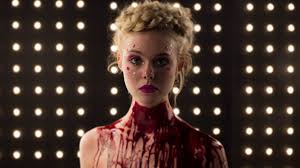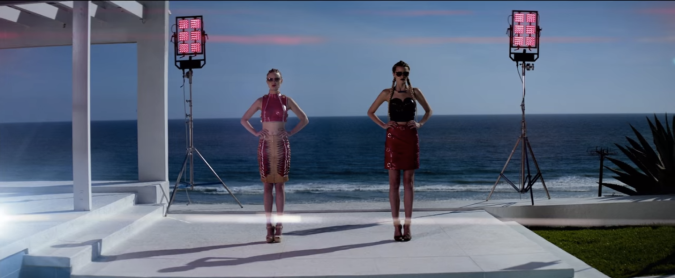
Jesse (Elle Fanning) at her opening photoshoot.
Directed by Nicolas Winding Refn (Only God Forgives, Drive) and starring Elle Fanning and Keanu Reeves, this 2016 psychological horror draws attention to society’s obsession with beauty, female sexuality and power and the intermingling of all three. With average ratings on both IMDb (6.3/10) and Rotten Tomatoes (57%), The Neon Demon sparked a lot of debate between critical responses and spectators, who felt that the film lacked substance and brushed over its flaws with overdramatic effects and camera techniques like a bad combover.
This film, in my opinion, is one of the most intriguing horror films ever made. It is complex, dark and compelling, and although long-winded and artsy in a way that makes it difficult to watch, once you see the film as a whole, its messages become clear and concise, echoed by the breath-taking cinematography and precise camera effects.
Jesse (Fanning), a beautiful young woman, takes part in a photoshoot with photographer Dean (Karl Glusman) where she is covered in blood. Cleaning herself up afterward, she meets make-up artist Ruby (Jena Malone), who takes her to a party and introduces her to her model friends: Gigi (Bella Heathcote) and Sarah (Abby Lee Kershaw). They probe Jesse about her sex life in the toilets, which Jesse is mysterious about.
Jesse meets with agent Jan (Christina Hendricks), who wants to sign her. After concurring that she’s underage, Jan gives Jesse a consent form to be signed by her parents and tells Jesse to tell anyone who asks that she is 19: ’18 is too on-the-nose’. Jesse later signs this alone in her motel room.
After going on a date with Dean, Jesse returns to her motel room to find a big cat inside. Shocked, she asks the motel management for help, and they find a cougar-looking cat prowling around her ransacked room. The creepy manager (Keanu Reeves) demands that she pays for the damages.
***START OF SPOILERS***
Jesse is booked onto a test shoot with renowned photographer Jack McCarthur (Desmond Harrington), who orders a closed set and covers her naked body with gold paint. The shoot is a success, and Gigi and Sarah start to envy her whereas Ruby becomes more and more entranced. Later, Sarah and Jesse both go to a casting call for a fashion designer Robert Sarno, in which he ignores Sarah and is enthralled by Jesse, taking her measurements. Sarah, humiliated and hurt, breaks a mirror in the bathroom. Jesse hears her and goes inside. Sarah asks her what it’s like to ‘be the sun’ in winter, and Jesse whispers ‘it’s everything’. Angry, Sarah pushes Jesse back into glass, and her hand is punctured. Sarah sucks the blood from her hand, and Jesse flees.
Back at the motel, Jesse is faint and answers the door to Dean, holding flowers, and promptly faints, having bizarre hallucinations. Dean confronts the motel manager and pays the damages. The manager says that he should be ‘getting something in return’ from Jesse, and suggests that if she’s unwilling, there’s a 13-year-old runaway in the room next door. Disgusted, Dean walks away.
At Sarno’s fashion show, Gigi spots Jesse, surprised that she’s there as Sarno doesn’t let just anyone in his show. She then details how much plastic surgery that she’s had, saying with pride that her surgeon calls her ‘the bionic woman’. Jesse is called in for a meeting with Sarno, in which he tells her she is going to close the show. On the runway, Jesse hallucinates a mirror prism in which she kisses her own face and triangular shapes. After the show, Jesse goes with Dean to a bar where they bump into Sarno, Gigi and another model. Sarno springs into a chauvinistic monologue where he explains that you can always tell if beauty is engineered, and humiliates Gigi for her plastic surgery choices. Dean leaves when Jesse agrees with Sarno.
Back at the motel, Jesse has a nightmare that the manager breaks in and forces a knife down her throat in a sexual attack. She wakes up in time to hear someone jiggling the doorknob from outside, and leaps to lock the door. After a series of frustrated bangs, the perpetrator moves on to next door where the runaway was said to be, and Jesse listens to the horrifying sounds coming from inside. She calls Ruby who invites her over, but when she gets there, Ruby attempts to have sex with her. Revealing that she’s a virgin, she rejects Ruby and the next day at her day job as a make-up artist at a morgue, Ruby straddles a female blonde corpse, kissing the body and pleasuring herself.
Returning home, Ruby finds Jesse dressed in a formal gown on the diving board above the empty swimming pool. Revealing herself to be completely assimilated to her new narcissistic way of life, Jesse gives a speech about how she knows that women would kill to be a half-rate version of herself and walks away. She is ambushed inside by Gigi and Sarah, who chase her with knives outside, where she is then pushed into the empty pool by the group of women. Gigi and Sarah wash her blood off in the shower, whilst Ruby looks on from a bath full of blood.
The next day, Ruby washes the blood from the swimming pool topless, covered in occult tattoos, and lays in a shallow grave. That evening, she lies on the floor in front of the full moon as blood gushes from her genitals.
Sarah and Gigi drive to a fashion shoot. Sarah is not involved in the shoot, but talks with the other model as their make-up is applied, telling her that she ate a girl who got a job over her whilst Gigi looks on in repulsion and fear. Jack McCarther is fascinated with Sarah and asks her to join Gigi in the fashion shoot, firing the other girl. As the women take their place on the set in front of a pool, Gigi starts to retch and runs inside. After a few minutes, Sarah follows her, finding her in the bathroom where she throws up an eye and opens her stomach with scissors, crying that she has to get ‘her’ out of her. Unmoved, Sarah eats the eye, and returns outside to the shoot.
***END OF SPOILERS***
Okay, so this was a difficult film to watch. Not because there was a lot of gore or sinister scenes (although there was a fair amount of that), but because a lot of the messages of the film were shrouded in metaphors and you had to really give the film all your attention to catch what it was the filmmakers were saying. I believe that this is a film about the modelling industry on the surface, but underneath it is about feminine sexuality linked to innocence and the perverted male and female obsession with beauty. Narcissism, jealousy and power trips are all outcomes of these loosened moral boundaries, and the result ended in chaos and violence.
This was a film with a lot to say, and I think that because these things are all closely linked in the real world, a book would be a better medium used to explore these intermingling and complex ideas. As it is, the film does convey a lot of that message, but sacrifices a lot of its potential audience in the process.
Scores on the doors:
Gore 7/10
There isn’t a lot of gore in this film – a lot of the damage is done off screen, and the audience is forced to imagine the carnage being done. However, blood is never far from the screen, from the first scene at the photoshoot to one of the final shots with a pool of blood on the floor. This leant itself to the dreamy atmosphere of the film, but lacked a bit of bite.
Disturbance/Creepiness 8/10
This was a film founded on the erotic creepiness, the darkness permeating through and infecting the beauty industry, and this is produced mostly by the incredible cinematography, although all men but one are creepy as fuck, and handle the models as if they were their own puppets, playing at tea with their plastic dolls and pitting them against each other (similar to real life, amirite, ladies?).
Originality 9/10
Although this film has been slated for borrowing bits from other surrealist filmmakers (Dali, Buñuel, Lynch), this film does only exactly that: it borrows. Inspired by these directors, the film is leant the dreamlike quality that only the surrealists could achieve with the dramatic urgency of a horror film. It is also an insightful and necessary film, reflective of today’s problematic morals and priorities.
Scariness (behind-the-sofa factor) 4/10
So this film was not scary. Not at all. Not in a ‘I’m holding my hands over my eyes, I can’t watch this’ sort of way, anyway. However, the fact that we place so much pressure on beauty, especially female beauty, that this sort of thing may come to pass preyed on my mind long after the credits stopped rolling.
Music score 9/10
With my penchant for orchestral scores, I was pleasantly surprised by this movie’s electro soundtrack. The other-worldly atmosphere of the score gave a slightly futuristic and insistent beat to the story unfolding, which made you unsure if whether you were watching was a fashionable party, or the quickening heartbeat of a victim.
Weapons 5/10
Other than some knives and a pair of scissors, the metaphorical weapon was the veil of beauty, which not only covers the wearer with an impenetrable shield, but infects passers by with enough jealousy and obsession to either stamp out or obtain the owner.
Cinematography/direction 10/10
Neon-coloured palettes and geometric shapes were a motif in Refn’s interpretation, as well as symmetric shots and pops of colours in otherwise bleak surroundings. This is truly a film to be experienced rather than watched, and the cinematography plays a larger role in the unsettling tone of the movie than the plot itself.
Setting 7/10
Set in L.A, we assume in modern times, the bright lights and sunny streets never play a part in this film, which is almost entirely made up of shots of interiors. This hints at an isolated and artificial living space for the characters, informing their behaviour and encouraging the worst in humankind.
Script 8/10
Observant and well-written, the script grounded the film, which otherwise would have floated off into obscurity with the giant, unreachable balloon of its cinematography. The scenes where the women converse are the most interesting, mimicking the forced sincerity and sceptical attention of competitors meeting the next big thing.
Entertainment 8/10
Although I massively enjoyed this and would have awarded the experience a higher score, I recognise that this is in no way the film for everybody, and in fact isolates some of the more casual viewers with a film style that might feel overstated for some and incredibly underwhelming for others.
Overall: 75/100
Throughout this film, I got very strong Black Swan vibes (circa 2011): potentially from the plot, also following competing women, but mostly from the style. Both enigmatic in their approach to horror, their delight comes in the unexpected: and as horror fans know that more often than not there are certain rules of the genre, this is a welcome and refreshing change. Had this been filmed in a more ‘traditional’ horror style, it would have passed, unremarked, in the theatres and taken its place as a B list slasher film, with no originality. As it is, the creepiness supplied by the cinematography, the superb acting from the female leads as well as the incredibly original music score came together to create a surrealist horror film, which no doubt will not please everyone, but which highlighted topics that the genre has not given enough screen time or attention.

Sarah and Gigi at the final photoshoot.